Anti-Monomethyl auristatin E (Anti-MMAE) monoclonal antibody (mAb) : Products and Application
Product Description
|
Cat No.
|
GMP-Bios-MMAE-Ab-2
|
|
Product Name
|
Anti-Monomethyl auristatin E (MMAE) mouse monoclonal antibody(mAb)
|
|
Target
|
Monomethyl auristatin E (MMAE)
|
|
Expression platform
|
mammalian cell
|
|
Isotypes
|
Mouse IgG
|
|
Bioactivity validation
|
Monomethyl auristatin E (MMAE) binding, Competitive immunoassay validation (Competitive ELISA) in Monomethyl auristatin E (MMAE) level test.
|
|
Tag
|
mFc
|
|
Products description
|
Anti-Monomethyl auristatin E (MMAE) mouse monoclonal antibody(mAb) is expressed from mammalian cell.
|
|
Specics
|
Mouse
|
|
Purity
|
Purity: ≥95% (SDS-PAGE)
|
|
Application
|
Competitive immunoassay validation (Competitive ELISA) and other Immunoassay, PK & PD assay for MMAE payload of Antibody-drug Conjugate (ADC).
|
|
Formulation
|
Lyophilized from sterile PBS, PH 7.4
|
|
Storage
|
Store at -20℃ to -80℃ under sterile conditions. Avoid repeated freeze-thaw cycles.
|
Product Details
Monomethyl auristatin E (MMAE; SGD-1010) is a synthetic derivative of dolastatin 10 and functions as a potent mitotic inhibitor by inhibiting tubulin polymerization. MMAE is widely used as a cytotoxic component of antibody-drug conjugates (ADCs) to treat several different cancer types. It is very important to detect the level of MMAE before the clinic. To make it easier to detect MMAE, GeneMedi has developed Anti-Monomethyl auristatin E (MMAE) mouse monoclonal antibody.
Check the product information of Antibody-drug Conjugates (ADC) with this link:
What is Monomethyl auristatin E (MMAE)?
1 Introduction and structure of MMAE
Monomethyl auristatin E (MMAE; SGD-1010) is a synthetic derivative of dolastatin 10 and functions as a potent mitotic inhibitor by inhibiting tubulin polymerization. Tubulin is the composition of microtubules. Microtubules are the main component of cytoskeleton. The use of tubulin inhibitors can interfere with mitosis, change the cytoskeleton structure of cells, and lead to the death of tumor cells. Because tumor cells divide faster than most normal cells, tubulin inhibitors are particularly effective against cancer cells.Because of its toxicity, it cannot be used as a drug itself, instead, it is linked to a monoclonal antibody (MAB) which directs it to the cancer cells. MMAE is widely used as a cytotoxic component of antibody-drug conjugates (ADCs) to treat several different cancer types. MMAE is actually desmethyl-auristatin E; that is, the N-terminal amino group has only one methyl substituent instead of two as in auristatin E itself.
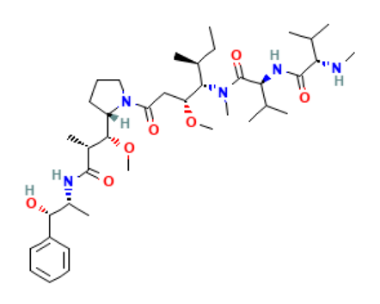
2 Perfect combination of small molecules and macromolecules in tumor therapy
For the traditional cancer treatment: chemotherapy, although it has a good killing effect on tumor cells. However, a really delicate balance between activity against cancer cells and systemic toxicity must be achieved. On this basis macromolecules (such as polymers, polysaccharides, and proteins) have been proposed to carry the active moiety, because they offer some relevant advantages: it has been established that high-molecular-weight conjugates passively accumulate in tumor tissue, because of the enhanced permeability of those tissues and the retention (EPR) effect [1,2]. Unlike their low-molecular-weight counterparts, macro-molecular drugs often encounter significant permeability barriers in the majority of normal tissues. In contrast, the poorly-formed tumor vasculature around solid tumors is more permeable to macromolecules than is normal vasculature [3,4].
In view of the characteristics of small molecules and macromolecules in tumor treatment, a variety of drugs coupled with antibodies and small molecule drugs(ADC) have been developed in recent years. MMAE is widely used as a hot small molecule drug.
The application of Monomethyl auristatin E (MMAE) in antibody-drug conjugates (ADCs)
The second generation ADC selects tubulin inhibitors as toxins. MMAE is the most widely used payload. For example, Adcetris, Polivy, padcev and vidicizumab all used MMAE.
Table1. FDA approved ADC that the payload is MMAE
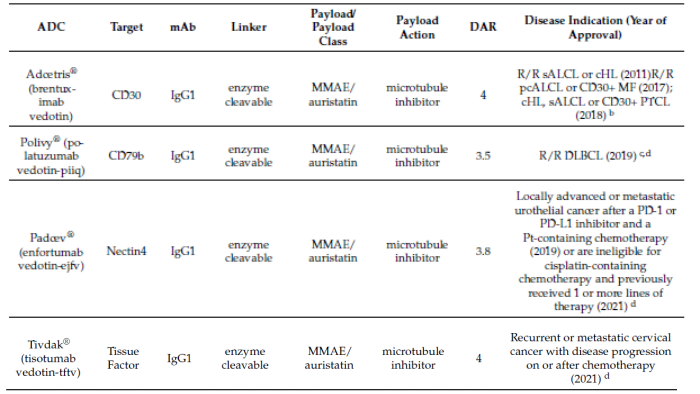
1 Brentuximab Vedotin(Adcetris :Seattlegenetics)
Brentuximab vedotin (adcetris: Seattle Genetics) targets CD30 on the surface of cancer cells. The antibody is linked to the payload MMAE via a protease cleavable linker Val-Cit. The linker is coupled with cysteine (Cys) residues on the antibody. Its DAR is 4. Brentuximab vedotin is internalized after attachment to CD30 and then transported to lysosomes. Protease cleavage in lysosomes releases MMAE into the cytoplasm, plays a cytotoxic role through MMAE, and induces apoptosis through cell cycle arrest. Brentuximab was approved by FDA in 2011 for the treatment of anaplastic large cell lymphoma (ALCL).
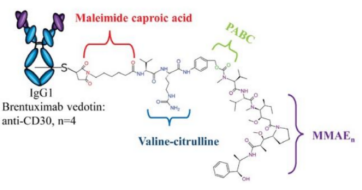
2 Polatuzumab Vedotin(Polivy: Genentech/Roche)
Polatuzumab vedotin (polyvy: Genentech / Roche) was approved by FDA in 2019 and EMA in 2020. It is an anti-CD79b monoclonal antibody. It is coupled with microtubule inhibitor monomethyl auristatin e (MMAE) through protease cleavable dipeptide linker Val citrulline (Val-Cit). As a component of B-cell receptor (BCR) complex, CD79b plays an important role in downstream BCR signal transduction and is expressed in most B-cell lymphomas, making it a feasible therapeutic target for B-cell NHL. Once ADC binds to CD79b on the surface of tumor cells and is internalized, Val-Cit linker will be cleaved by lysosomal protease to release the active agent MMAE. Then, MMAE combined with microtubules to inhibit cell division and induce tumor cell apoptosis. Its DAR is 3.5, the half-life of ADC is 12 days, and the estimated clearance rate is 0.9 L / day.
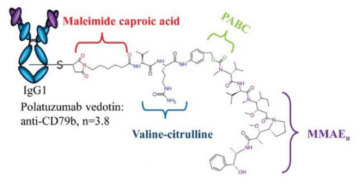
3 Enfortumab Vedotin (Padcev: Astellas Pharma/Seattle Genetics)
Padcev was approved by FDA in 2019 for the treatment of locally advanced or metastatic urothelial carcinoma. Padcev is connected to the cysteine residue of the antibody through the protease cleavable linker maleimide hexyl valine citrulline (MC Val-Cit), and the payload is MMAE. It targets the cell surface protein Nectin-4. Its DAR is 3.8. Once the ADC is internalized, the linker is cleaved by the protease and releases the payload. MMAE then binds to tubulin and inhibits microtubule polymerization leading to apoptosis. The half-life was 3.4 days and the clearance rate was 0.10 L / h.
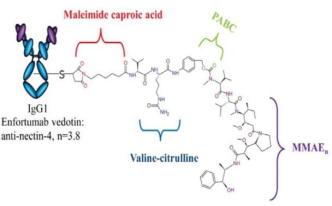
4 Tisotumab vedotin-tftv(Tivdak: Genmab/Seagen)
On September 20, 2021, FDA accelerated the approval of “first in class” antibody coupled drug tivdak (tisotumab vedotin tftv) to be listed for the treatment of patients with recurrent or metastatic cervical cancer. Tivdak is the first antibody drug conjugate targeting tissue factor (TF) approved by FDA. The antibody is a monoclonal antibody targeting tissue factor (TF). It couples the cytotoxic drug MMAE to the monoclonal antibody through a linker that can be cleaved by protease. Tissue factor is an antigen expressed on the surface of cervical cancer cells. Tivdak releases MMAE after endocytosis, which can disrupt the microtubule network of dividing cells, leading to cell cycle arrest and cell death.
This approval was based on the results of a clinical trial involving 101 patients with recurrent or metastatic cervical cancer. They received up to two types of pre systemic treatment, including at least one platinum containing chemotherapy. The results showed that tivdak achieved an objective response rate of 24% (95% CI, 15.9-33.3). The median duration of remission (DOR) was 8.3 months.
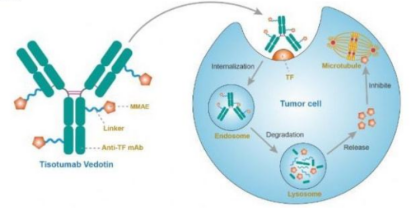
How to detect Monomethyl auristatin E (MMAE)?
ADCs are complex molecules with unique critical quality attributes. Considering the heterogeneity and complex changes in ADC concentration and composition after ADC administration, three analytes are routinely measured in order to characterize the PK properties of an ADC: antibody-conjugated MMAE (AcMMAE), total antibody, and unconjugated MMAE. Pharmacokinetic (PK) study is necessary for drug discovery and development process to help understand and predict the behavior of drugs and to link with the pharmacodynamics or toxicological effects of drugs [6,7]. Due to highly cytotoxic characteristics, PK studies of the payloads used for ADCs are important in understanding the behavior of the payloads [8,9].
Besides, a very sensitive assay is also required due to a very low dose of the payloads, and, therefore, routine analytical methods, such as LC-UV, etc., are not appropriate for the quantification of the payload drugs. It has developed anti-MMAE antibodies and paired conjugates suitable for ADC ELISA assay development. It can be used in the quantitative determination of antibody-MMAE-conjugate level in test sample for pre-clinical and clinical pharmacology study of MMAE ADC.
BSA-MMAE conjugate is designed with similar linker chemistry as ADC and is synthesized for our customers’ usage in immunization or immunoassay. First, thiol functional groups are introduced to the BSA followed by reaction of the maleimide group of Mc-VC-PAB-MMAE to form the conjugate.

Next, BSA-MMAE was immunized to obtain anti-MMAE antibody, Then, different labeling methods are adopted for antibodies, which correspond to different detection methods. The highly sensitive” direct ELISA”/ “sandwich” ELISA is intended for use in the quantitative determination of antibody MMAE conjugate level in serum or plasma of human, mouse, rat, primate, etc. It is useful for pre-clinical and clinical pharmacology study of MMAE Antibody Drug Conjugate (ADC). In ELISA detection, there are three methods that can be used for anti MMAE detection: “sandwich” ELISA and competitive ELISA.
1 Sandwich ELISA to detect MMAE in vitro
The sandwich ELISA measures the amount of antigen between two layers of antibodies. The antigens to be measured must contain at least two antigenic sites, capable of binding to antibody, since at least two antibodies act in the sandwich. So sandwich assays are restricted to the quantitation of multivalent antigens such as proteins or polysaccharides. Sandwich ELISAs for quantitation of antigens are especially valuable when the concentration of antigens is low and/or they are contained in high concentrations of contaminating protein.
· Coating antibody anti-antibody of ADC(1ug/ml) on microplate, store at 4℃ overnight
· Gently remove the liquid,wash the plate 3 times with PBS(pH=7.4). Add 1% BSA to block at 37℃ for 1h.
· Gently remove the liquid,wash the plate 3 times with PBS(pH=7.4). Gradient dilution was carried out with 1ug / ml ADC to made a standard curve. And the dose of ADC has been shown in Tbable2. Incubate at 37℃ for 1h. At the same time, the OD450 of the sample to be tested is substituted into the standard curve to calculate the concentration of total MMAE which in serum or plasma of human, mouse, rat, primate, etc.
· Gently remove the liquid,wash the plate 3 times with PBS(pH=7.4). Add HRP labeled anti-MMAE antibody(1ug/ml) and incubate at 37℃ for 1h.
· Gently remove the liquid,wash the plate 3 times with PBS(pH=7.4), add TMB chromogenic solution . After a few minutes, 1M sulfuric acid solution was added to terminate the reaction.
· Microplate reader to detect the OD450 and analysis the data.
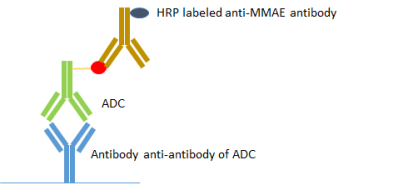
Table 1. Advantages and limitation of different expression system
| MMAE(ng/ml) | Standard(OD450) | Corrected(OD450) | |
|---|---|---|---|
| A | 0 | a | 0 |
| B | 1.37 | b | b-a |
| C | 4.12 | c | c-a |
| D | 12.35 | d | d-a |
| E | 37.04 | e | e-a |
| F | 111.11 | f | f-a |
| G | 333.33 | g | g-a |
| H | 1000 | h | h-a |
2 Competitive ELISA
Competitive ELISA is a strategy that is commonly used when the antigen is small and has only one epitope or antibody binding site. One variation of this method consists of labeling purified antigen instead of the antibody. Unlabeled antigen from samples and the labeled antigen compete for binding to the capture antibody. A decrease in signal from the purified antigen indicates the presence of the antigen in samples when compared to assay wells with labeled antigen alone.
· Coating BSA-MMAE(1ug/ml) on the microplate and put it at 4℃ overnight. Wash it with PBS(pH=7.4) for 3 times, Block the microplate with 1% BSA. Incubate for 1 hour at 37°C. At the same time, prepare the antigen/antibody mixture by adding 50μl gradient concentration of MMAE standard sample to 50μl anti-MMAE antibody(1ug/ml) for each well in the assay. Incubate for 1 hour at 37°C.
· Wash it 3 times with PBS(pH=7.4), then add the MMAE/anti-MMAE antibody mixture in each well. Incubate at 37℃ for 1h.
· Wash the microplate with PBS(pH=7.4), then add HRP labeled secondary antibody(1 ug/ml) and incubate at 37℃ for 1h.
· Wash it 3times withPBS(pH=7.4), add TMB chromogenic solution. After a few minutes, 1M sulfuric acid solution was added to terminate the reaction.
· Microplate reader to detect the OD450 and analysis the data. It means lower antigen concentration will output higher signal.
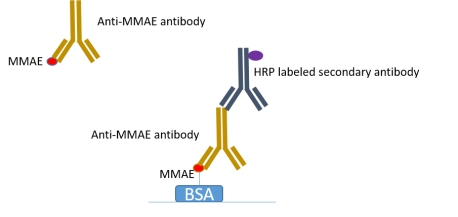
Anti-Monomethyl auristatin E (MMAE) monoclonal antibody(mAb)
After ADC internalization, the released MMAE in the tumor cells can enter surrounding cells and cause bystander killing [11]. This advantage of MMAE leads to an efficient killing of tumor cells. However, it can also cause toxicity to healthy cells. While MMAE-conjugated ADCs are efficacious, hematological adverse reactions such as neutropenia (≈21%) and thrombocytopenia (≈10%) are consistently reported [12,13]. Moreover, peripheral neuropathy (≈44%) is also a predominant adverse effect in the clinic (≈44%) [13,14]. It is generally believed that these toxicities stem from the pharmacological effects of the payload. However, limited studies have investigated whole-body pharmacokinetics (PK) of MMAE. While it is impossible to conduct such studies in humans due to the inherent toxicity of MMAE, preclinical studies that investigate whole-body PK of MMAE are required to better understand the disposition of this molecule and to facilitate preclinical-to-clinical translation of exposure–response relationships developed for MMAE-conjugated ADCs.
Therefore, it is very important to detect the level of MMAE before clinic. For example, the determination of the concentration of coupled MMAE in ADC, anti MMAE is necessary. Therefore, it is very important to detect the level of MMAE before clinic. For example, the determination of the concentration of coupled MMAE in ADC, antiMMAE is very convenient and fast. Of course, the PK of MMAE in ADC drugs in animal experiments is more important. Taking mice as an example, the traditional analysis may need to be through liquid phase analysis, which may have higher requirements for equipment and operation. However, when we use anti MMAE to detect the PK of mouse tumor model after administration, we have great advantages. Anti MMAE can be directly used to detect the samples to be tested and blood obtained after treatment in tissues and organs. The following is the application of anti MMAE antibody
· Study on drug delivery (ADC) of tumor cells cultured in vitro.
· Study on pharmacokinetics of animal tumor models (e.g. rats) after administration (ADC).
· Detection of MMAE in plasma of preclinical patients after administration.
Reference
2. Dean AQ, Luo S, Twomey JD, Zhang B. Targeting cancer with antibody-drug conjugates: Promises and challenges. MAbs. 2021 Jan-Dec;13(1):1951427. doi: 10.1080/19420862.2021.1951427. Erratum in: MAbs. 2021 Jan-Dec;13(1):1966993. PMID: 34291723; PMCID: PMC8300931.
3. Coats S, Williams M, Kebble B, Dixit R, Tseng L, Yao NS, Tice DA, Soria JC. Antibody-Drug Conjugates: Future Directions in Clinical and Translational Strategies to Improve the Therapeutic Index. Clin Cancer Res. 2019 Sep 15;25(18):5441-5448. doi: 10.1158/1078-0432.CCR-19-0272. Epub 2019 Apr 12. PMID: 30979742.
4. Abedi M , Cohan R A , Mahboudi F , et al. MALDI-MS: a Rapid and Reliable Method for Drug-to-Antibody Ratio Determination of Antibody-Drug Conjugates[J]. Iranian biomedical journal, 2019, 23(6).
5. Xuejing, Yao, Jing, et al. A novel humanized anti-HER2 antibody conjugated with MMAE exerts potent anti-tumor activity[J]. Breast Cancer Research&Treatment, 2015.
6. Su Z , Xiao D , Xie F , et al. Antibodydrug conjugates: Recent advances in linker chemistry[J]. Acta Pharmaceutica Sinica B, 2021.
7. Chen Y , Kim M T , Zheng L , et al. Structural Characterization of Cross-Linked Species in Trastuzumab Emtansine (Kadcyla)[J]. Bioconjugate Chemistry, 2016.
8. Seki H , Walsh S J , Bargh J D , et al. Rapid and robust cysteine bioconjugation with vinylheteroarenes. 2021.
9. Kostova V, Désos P, Starck JB, Kotschy A. The Chemistry Behind ADCs. Pharmaceuticals (Basel). 2021;14(5):442.
10. Kostova, V.; Désos, P.; Starck, J.-B.; Kotschy, A. The Chemistry Behind ADCs. Pharmaceuticals 2021, 14, 442.
11. Singh A P , Sharma S , Shah D K . Quantitative characterization of in vitro bystander effect of antibody-drug conjugates[J]. J Pharmacokinet Pharmacodyn, 2016, 43(6):567-582.
12. Aleksandr V. Yurkovetskiy;Natalya D. Bodyak;Mao Yin;A Novel Antibody–Drug Conjugate Platform Featuring High Drug Loading and a Controlled Bystander Effect
13. Mol Cancer Ther (2021) 20 (5): 885–895.
14. Tong JTW, Harris PWR, Brimble MA, Kavianinia I. An Insight into FDA Approved Antibody-Drug Conjugates for Cancer Therapy. Molecules. 2021;26(19):5847. Published 2021 Sep 27. doi:10.3390/molecules26195847






